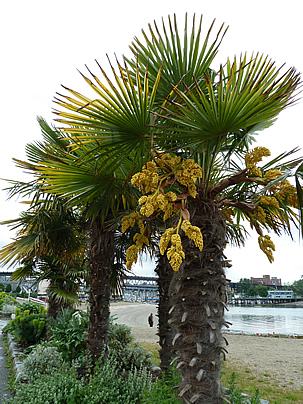The Chinese Windmill Palm (Trachycarpus fortunei) is a dioecious, ornamental species native to temperate and subtropical regions of China, Japan, Burma, and India. It has become known in various parts of the world for its preference for subtropical climates and its resistance to intense cold, making it a top choice for colder regions where other species would perish in the first winter.
It has a single, thickened stem (trunk) at its base, covered with a dense layer of dark fibers and the base of the fallen leaves’ petioles. The leaves are fan-shaped, segmented from the middle into long and often pendulous filaments. The leaves have strong petioles and are densely arranged, forming a compact, rounded crown. It blooms in the summer, in dense plumose panicles, with numerous small yellow flowers, in separate sexes. Female plants, if pollinated, produce oblong, dark blue drupe-type fruits.
Among trunked palms, this is the most cold-resistant species, allowing landscapers in temperate climate countries to bring a tropical feel to their designed gardens. Despite its affinity for the cold, it is still a palm tree, which always gives us the sense of vibrant tropicality.
Therefore, in cold and mountainous regions, such as the highlands and the far south of Brazil, where intense frosts occur annually, we can cultivate this beautiful palm tree in all its exuberance. Under optimal conditions, it can grow about a foot (30.48 centimeters) per year. Use it individually, in groups, or rows, suitable for both small or extensive gardens, and even close to buildings or pools, as its roots are not aggressive.
When young, chinese windmill palms can also be planted in pots and grown as indoor plants in well-lit environments. An interesting fact: in China, the stem fibers of Trachycarpus fortunei are used in making mats, brooms, and rustic blankets.
It should be grown in full sun or partial shade, in slightly acidic and well-draining soil, enriched with organic matter and regularly irrigated. Well-established plants can withstand intense cold, down to -20°C (-4°F), as well as frost and snow. However, it’s important to protect them from strong winds, to which they are quite sensitive.
They do not tolerate excessively wet soils, prone to waterlogging, especially in winter, but are quite resistant to dry periods, with some impact on growth rate. Plants grown in warmer climates thrive better when partially shaded and with supplementary irrigation. Fertilize with palm-specific fertilizers during the spring and summer months. Suspend watering in winter or reduce it to the minimum necessary.
The chinese windmill palm can be propagated from seeds, which should be removed from ripe fruits and planted as soon as possible, at temperatures between 18°C and 21°C (64.4°F to 69.8°F), with sandy substrate with good water retention capacity but not waterlogged. They germinate in a few weeks. Fertile seeds are obtained only from female plants cultivated with both sexes minimally close. Seedlings will be ready for transplanting after one year of planting.


